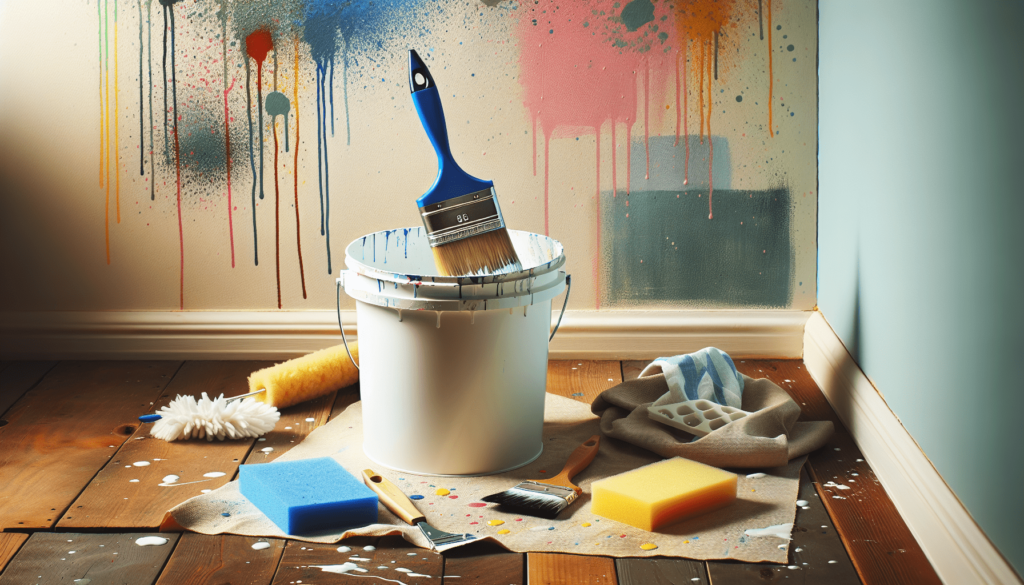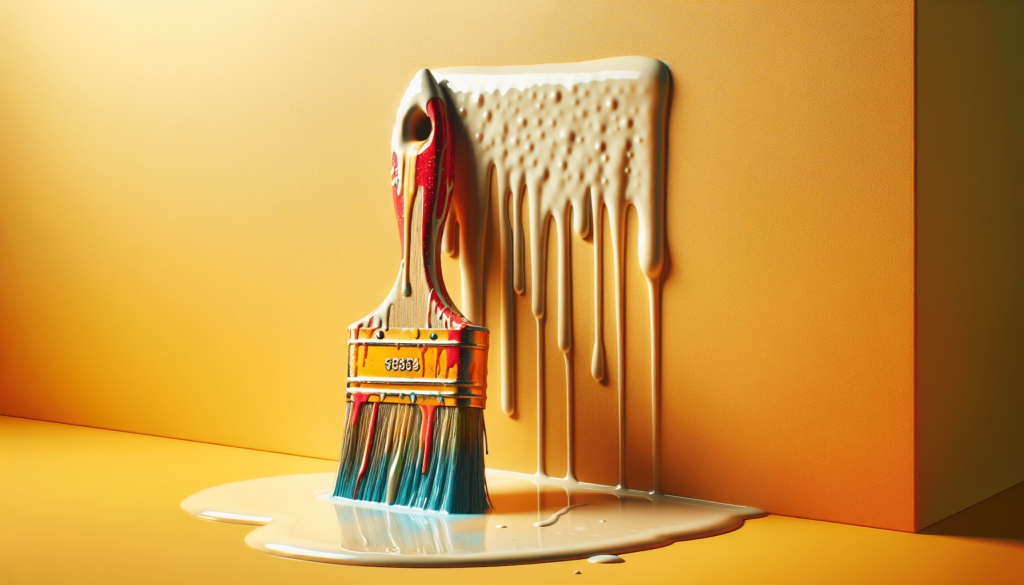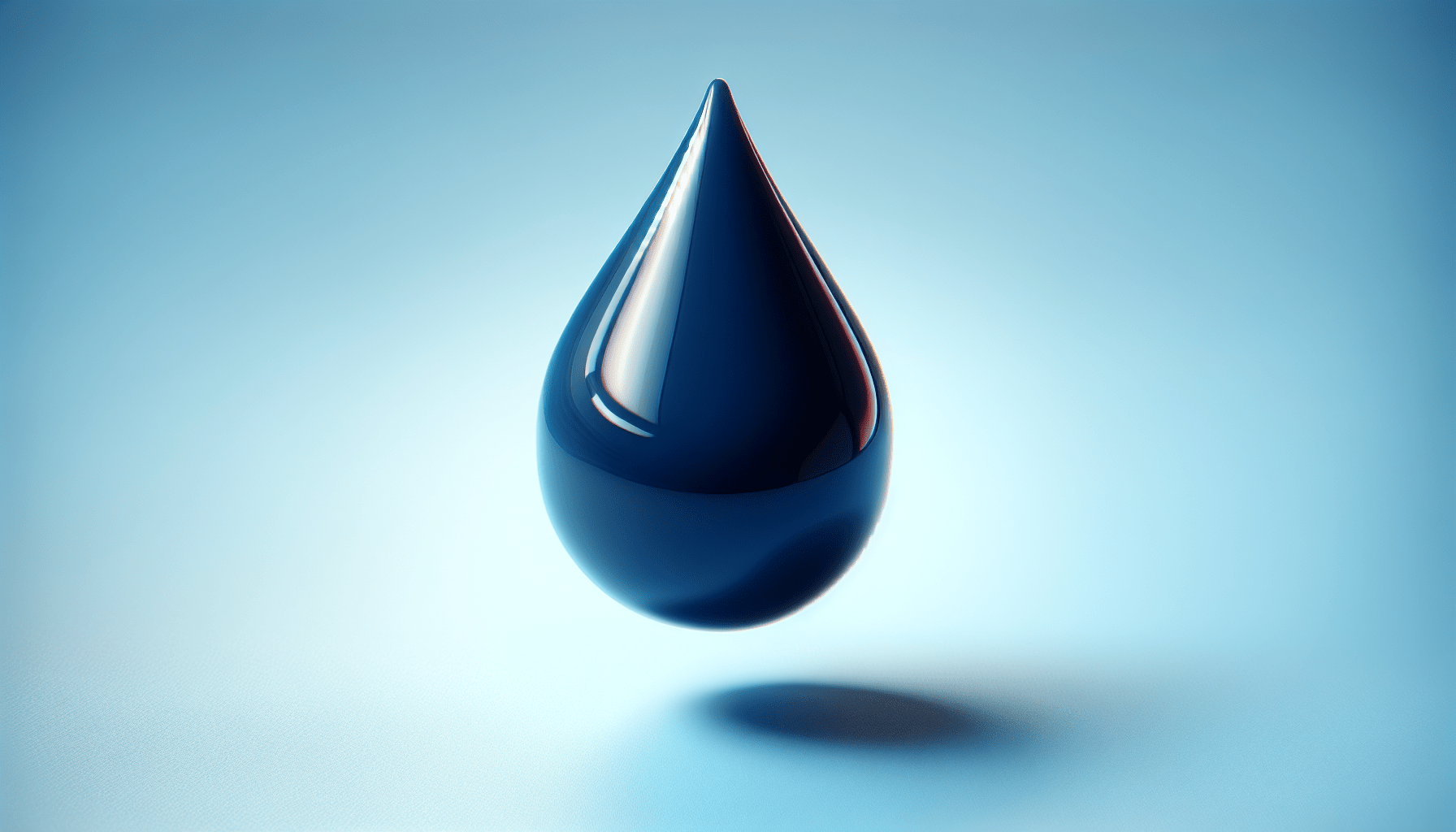Cleaning up latex paint can be a daunting task, especially if you’re unsure of the proper methods. But fear not, in this article, you will learn exactly how to effectively clean latex paint off various surfaces. Whether it’s a spill on your favorite clothing or an accidental brushstroke on your walls, we’ve got you covered with step-by-step instructions and expert tips. By the end of this article, you will be equipped with the knowledge to tackle any latex paint mess confidently and restore your surfaces to their pristine state. So let’s dive in and discover the secrets of efficient latex paint cleanup.

Preparing the Work Area
Before starting the process of cleaning latex paint, it is important to properly prepare the work area. This ensures that the cleaning process goes smoothly and efficiently.
Gather necessary materials
To clean latex paint effectively, you will need a few materials. Collect a clean cloth, a sponge, mild soap, warm water, vinegar, rubbing alcohol, ammonia, acetone or nail polish remover, and a power washer if necessary. Having these materials on hand will make the cleaning process easier and more efficient.
Protect surrounding surfaces
When cleaning latex paint, it is important to protect the surrounding surfaces from any potential damage. Place drop cloths or plastic sheets on the floors and furniture near the painted surface. This will prevent any accidental spills or splatters from causing damage to these surfaces.
Ventilate the area
Another crucial step in preparing the work area is to ensure proper ventilation. Open any windows or doors near the painted surface to allow fresh air to circulate. This will help to minimize any fumes or odors that may be present during the cleaning process, making it a safer and more comfortable environment to work in.
Removing Excess Paint
Before diving into the cleaning process, it is important to remove any excess paint from the surface. This will make the following cleaning methods more effective.
Blot the paint with a clean cloth
If the latex paint is still wet, start by blotting the surface with a clean cloth. This will help absorb as much of the excess paint as possible before it dries. Gently press the cloth onto the painted surface, being careful not to rub or smear the paint, as this can cause it to spread and become more difficult to remove.
Scrape off dried paint
For dried latex paint, carefully scrape off any excess paint using a paint scraper or a putty knife. Hold the scraper or knife at a shallow angle and gently scrape away the paint. Be cautious not to apply excessive pressure, as this could damage the underlying surface. Take your time and work slowly to avoid any mishaps.
Use a paint stripper if needed
If the previous methods do not completely remove the excess paint, a paint stripper can be used as a last resort. Choose a paint stripper that is suitable for latex paint and follow the manufacturer’s instructions carefully. Apply the paint stripper to the remaining paint and allow it to sit for the recommended amount of time. Use a scraper to remove the softened paint, again being careful not to damage the surface beneath.
Using Soap and Water
One of the most common methods for cleaning latex paint is using soap and water. This method is safe and effective for most painted surfaces.
Combine warm water and mild soap
To create a cleaning solution, combine warm water with a few drops of mild soap. Mix the solution until it is well blended. The warm water helps to loosen the paint and the mild soap helps to break down any dirt or grime that may be present on the painted surface.
Dampen a clean cloth or sponge
Once the cleaning solution is ready, dampen a clean cloth or sponge in the solution. Make sure the cloth or sponge is not dripping wet, but rather slightly dampened. Excess water can lead to streaks or water damage on the painted surface.
Gently scrub the painted surface
With the dampened cloth or sponge, gently scrub the painted surface in circular motions. Start with light pressure and increase if necessary, but be careful not to scrub too vigorously, as this can damage the paint or the underlying surface. Continue scrubbing until the paint is successfully removed. Rinse the cloth or sponge frequently to avoid spreading the paint around.
Trying Vinegar and Water
If the soap and water method did not completely remove the latex paint, vinegar and water can be used as an alternative.
Create a vinegar solution
In a clean container, mix equal parts of vinegar and water to create a vinegar solution. Vinegar is a natural and effective cleaner that can help break down tough stains, including latex paint.
Apply the solution to the paint
Using a clean cloth or sponge, apply the vinegar solution directly to the paint. Allow the solution to sit on the painted surface for a few minutes, giving it time to penetrate and dissolve the paint.
Scrub the surface with a cloth or sponge
After the vinegar solution has had time to work, gently scrub the painted surface using a cloth or sponge. Apply light pressure and use circular motions to lift and remove the paint. Be cautious not to scrub too hard, as this can cause damage to the surface. Rinse the cloth or sponge frequently to avoid spreading the paint.

Utilizing Rubbing Alcohol
Rubbing alcohol is another effective option for cleaning latex paint, especially if the paint has dried.
Dilute rubbing alcohol with water
To create a cleaning solution, dilute rubbing alcohol with an equal amount of water. This helps to reduce the potency of the alcohol, making it safer to use on painted surfaces.
Apply the mixture to the paint
Using a clean cloth or sponge, apply the diluted rubbing alcohol mixture to the paint. Allow the solution to sit on the paint for a few minutes to soften it.
Scrub the area with a cloth or sponge
After the rubbing alcohol has had time to work, gently scrub the painted surface using a cloth or sponge. Apply light pressure and use circular motions to lift and remove the paint. Be cautious not to scrub too hard to avoid damaging the underlying surface. Rinse the cloth or sponge regularly to prevent spreading the paint.
Applying Ammonia Solution
Ammonia is a strong cleaning agent that can be effective in removing latex paint. However, it is important to use caution when working with ammonia.
Mix ammonia with water
In a well-ventilated area, mix equal parts of ammonia and water in a clean container. It is essential to handle ammonia with care, as it can be harmful if inhaled or if it comes into contact with the skin.
Test the solution on a small area
Before applying the ammonia solution to the entire painted surface, test it on a small, inconspicuous area. This will help ensure that the solution does not cause any damage or discoloration to the paint or the underlying surface.
Scrub the paint with the ammonia solution
Once the solution has been tested and deemed safe, apply it to the paint using a clean cloth or sponge. Allow the solution to sit on the paint for a few minutes to soften it. Then, gently scrub the painted surface using light pressure and circular motions. Rinse the cloth or sponge frequently to avoid spreading the paint.
Using Acetone or Nail Polish Remover
Acetone or nail polish remover can be effective in removing latex paint from surfaces. However, they should be used with caution as they can be harsh and may damage certain materials.
Check the area for compatibility
Before using acetone or nail polish remover, check the painted surface for compatibility. Test a small area to ensure that the remover does not cause any damage or discoloration to the paint or the underlying surface. Some materials, such as plastics or certain types of fabric, may be sensitive to acetone or nail polish remover.
Apply the acetone or remover to the paint
Using a clean cloth or sponge, apply a small amount of acetone or nail polish remover directly to the paint. Allow the remover to sit on the paint for a few minutes to soften it.
Scrub the surface with a cloth or sponge
Once the paint has been softened, gently scrub the painted surface using a cloth or sponge. Apply light pressure and use circular motions to lift and remove the paint. Be careful not to scrub too hard to prevent damage to the underlying surface. Rinse the cloth or sponge regularly to avoid spreading the paint.
Consider Power Washing
If other methods have not been successful in removing the latex paint, power washing can be a more aggressive approach.
Rent or purchase a power washer
Power washers can be rented from most home improvement stores, or if preferred, they can be purchased for personal use. Consider the size of the painted surface and the frequency of use before deciding whether to rent or purchase a power washer.
Fill the washer with water and cleaning solution
Before operating the power washer, fill it with water and the recommended cleaning solution. This will help effectively remove the latex paint from the surface. Follow the manufacturer’s instructions for filling and using the power washer for best results.
Carefully power wash the painted surface
While power washing can be an effective method for removing latex paint, it is important to exercise caution. Adjust the pressure of the power washer to a level that is safe for the painted surface, avoiding excessive force that could damage the underlying material. Keep the power washer at a distance to evenly distribute the pressure and prevent any concentrated areas from being affected.
Seek Professional Help
If all the aforementioned methods have been attempted without success or if the painted surface is delicate or valuable, it may be best to seek the assistance of a professional cleaner or painter.
Contact a professional cleaner or painter
Research and contact local professional cleaners or painters who specialize in paint removal services. Inquire about their experience, expertise, and techniques related to removing latex paint.
Discuss the paint removal process and costs
Schedule a consultation with the professional cleaner or painter to discuss the paint removal process and associated costs. They will be able to assess the specific requirements of the painted surface and provide an accurate quote for the job.
Schedule an appointment for professional cleaning
Once all the details have been finalized, schedule an appointment with the professional cleaner or painter for the paint removal service. Be sure to follow any specific instructions provided by the professional to ensure a successful and efficient cleaning process.
Post-Cleaning Care
After successfully removing the latex paint from the surface, it is important to take proper care to ensure a clean and pristine finish.
Inspect the painted surface for any residue
After the cleaning process, inspect the painted surface for any remaining paint residue. Use a clean cloth or sponge to gently wipe away any traces of paint that may have been missed during the cleaning process.
Rinse the area with clean water
To remove any cleaning solution or residue, rinse the area with clean water. This will help to ensure that no cleaning agents are left behind on the painted surface, which could potentially cause damage or discoloration.
Allow the surface to fully dry
Finally, allow the surface to fully dry before using or applying any additional products or treatments. This will ensure that the paint is completely dry and that the surface is ready for any further maintenance or finishing touches.
By following these comprehensive steps, you can effectively clean latex paint from various surfaces, leaving them looking refreshed and paint-free. Remember to always use caution and follow the instructions provided for each cleaning method to avoid any damage to the painted surface. With the right materials and techniques, you can achieve a clean and pristine finish, restoring the beauty of your surfaces.



